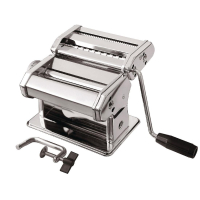Pasta Machines
Commercial pasta machines are game-changers for UK restaurants, Italian eateries, and catering businesses looking to serve fresh, authentic pasta. These robust workhorses transform your kitchen's capabilities with production rates from 2-15kg per hour and heavy-duty construction that withstands daily demands. After fitting countless professional kitchens over 50 years, we've seen how these machines elevate menus beyond pre-made options—complementing commercial mixers and refrigeration for a complete pasta operation. Whether you're crafting delicate ravioli or hearty tagliatelle, a quality pasta machine isn't just equipment—it's your ticket to menu authenticity and customer loyalty!
-
Commercial Pasta Machine | 6' Pasta Maker | Stainless Steel | Vogue J578
2.77In Stock
146H x 205W x 8D mm
Vogue
Chrome-plated steel construction
Chromed Steel
£44.98 £67.47 -
Commercial Pasta Machine | 8-Inch Fresh Pasta Maker | Stainless Steel Construction | Vogue GG737
3.24In Stock
158H x 245W x 198D mm
Vogue
Stainless steel body
Stainless Steel
£44.98 £67.47 -
Commercial Pasta Machine | Pasta Maker | Professional Pasta Roller with Ravioli Cutter | Vogue S635
5.1 kgIn Stock
146H x 205W x 205D mm
Vogue
Ravioli cutter fits on simply for perfect results
Stainless Steel
£71.40 £107.10 -
Pasta Machine | Pasta Maker | Manual Italian Pasta Roller | Imperia J408
3.45 kgout of stock
6H x 7W x 8D mm
Imperia
Allows you to make your own pasta from scratch
Chrome Plated
£119.68 £179.52 -
Manual Pasta Machine | Pasta Maker | Red | Imperia DA426
3.63In Stock
205H x 185W mm
Imperia
Makes creating your own fresh pasta easy
Chromed Steel
£132.98 £199.47 -
Commercial Egg Boiler | Electric Egg Cooker | 10 Egg Capacity | Roller Grill EB10
5kgIn Stock
260H x 400W x 205D mm
Roller Grill
1/3 GN
Stainless Steel
£444.99 £954.00 -
Commercial Pasta Cutter | Pasta Shaping Machine | Concerto Multi-function Model | Sirman DM687
1.6kgout of stock
240H x 420W x 190D mm
Sirman
Easy to fit and use
304 Stainless Steel
£769.48 £1,154.22 -
Manual Pasta Machine | Pasta Maker | Italian Pasta Roller | Imperia K581
11.15In Stock
265H x 315W x 210D mm
Imperia
Choose from 10 different thicknesses up to 9.5mm
Stainless Steel
£790.38 £1,185.57 -
Commercial Pasta Cutter | Fresh Pasta Machine | Bench Mounted | Sirman Sinfonia DM686
1.6kgIn Stock
200H x 310W x 140D mm
Sirman
Easy to fit and use
304 Stainless Steel
£797.98 £1,196.97 -
Commercial Pasta Machine | Linguine Maker | 3x1.6mm Die | Sirman Sinfonia 2 DM688-LIN
28kgout of stock
790H x 530W x 470D mm
Sirman
High-performance, easy-remove kneading paddle
Stainless Steel
£3,932.98 £5,899.47 -
Commercial Pasta Machine | Macaroni Maker | 8mm Die Included | Sirman Sinfonia 2 DM688-MAC
28kgout of stock
489H x 577W x 263D mm
Sirman
High-performance, easy-remove kneading paddle
Stainless Steel
£3,932.98 £5,899.47 -
Commercial Pasta Machine | Spaghetti Maker | 1.9mm Die | Sirman Sinfonia 2 DM688-SPA
28kgout of stock
650H x 420W x 470D mm
Sirman
High-performance, easy-remove kneading paddle
Stainless Steel
£3,932.98 £5,899.47 -
Commercial Pasta Machine | Pasta Maker with Tagliatelle Die | 6mm Width | Sirman Sinfonia 2 DM688-TAG
28kgout of stock
489H x 577W x 263D mm
Sirman
High-performance, easy-remove kneading paddle
Stainless Steel
£3,932.98 £5,899.47 -
Commercial Pasta Machine | Fusilli Pasta Maker | 8.4mm Die | Sirman Sinfonia 2 DM688-FUS
28kgout of stock
489H x 577W x 263D mm
Sirman
High-performance kneading paddle
Stainless Steel
£3,932.98 £5,899.47 -
Pasta Machine | Pasta Maker | Manual Hand Crank Machine | Imperia Chef in Casa GK033
30 kgIn Stock
300H x 290W x 550D mm
Imperia
Features a manual rotating pasta-cutter knife for short pasta
Fitted with a complete line of accessories (which can be purchased separately)
£4,787.98 £7,181.97 -
Commercial Pasta Machine | Pasta Maker | 1.9mm Spaghetti Die | Sirman Concerto 5 DM689-SPA
42kgout of stock
489H x 577W x 263D mm
Sirman
High-performance, easy-remove kneading paddle
304 Stainless Steel
£5,604.98 £8,407.47 -
Commercial Pasta Machine | Concerto 5 Pasta Maker | With Tagliatelle 6mm Die | Sirman DM689-TAG
42kgout of stock
630H x 665W x 305D mm
Sirman
High-performance, easy-remove kneading paddle
304 Stainless Steel
£5,604.98 £8,407.47 -
Commercial Pasta Machine | Pasta Maker with Fusilli Die | 8.4mm Attachment | Sirman Concerto 5 DM689-FUS
42kgout of stock
630H x 665W x 305D mm
Sirman
High-performance, easy-remove kneading paddle
304 Stainless Steel
£5,604.98 £8,407.47 -
Commercial Pasta Machine | Linguine Maker | 3x1.6mm Die | Sirman Concerto 5 DM689-LIN
42kgout of stock
489H x 577W x 263D mm
Sirman
High-performance, easy-remove kneading paddle
304 Stainless Steel
£5,604.98 £8,407.47 -
Commercial Pasta Machine | Pasta Maker | 5L Capacity with 8mm Macaroni Die | Sirman Concerto 5 DM689-MAC
42kgout of stock
630H x 665W x 305D mm
Sirman
High-performance, easy-remove kneading paddle
304 Stainless Steel
£5,604.98 £8,407.47
Commercial Pasta Machines for Restaurants & Caterers
Brands Trusted by Industry Professionals
Key Features and Benefits
- Multiple Die Options Create various pasta shapes from one machine—menu versatility sorted.
- Variable Speed Control Adjust production pace from gentle to rapid—perfect for varying demands.
- Durable Construction Heavy-duty stainless steel bodies—built for years of kitchen battles.
- High Output Capacity Produces 2-15kg/hour—keeps up with busy service periods.
- Cooling Systems Prevents overheating during extended use—consistent performance.
- Easy Maintenance Detachable parts for thorough cleaning—hygiene made simple.
- Safety Features Emergency stop buttons and anti-jam mechanisms—protects staff and machine.
- Compact Design Space-efficient footprints—fits in busy commercial kitchens.
Essential Buying Considerations
Capacity and Size
- Choose 2-5kg/hour models for smaller restaurants—saves counter space.
- Mid-range 5-10kg/hour units suit busy trattorias—balances output and footprint.
- Large 10-15kg/hour machines for high-volume operations—when demand never stops.
Power Source and Usage
- Most run on standard 13A plugs—check your kitchen's electrical capacity.
- Consider 370W-750W models for smaller venues—energy-efficient choice.
- Pair with dough mixers for a complete pasta-making setup.
How Commercial Pasta Machines Work
Commercial pasta machines work through a beautifully simple yet effective process. First, your dough mixture (typically flour and eggs) enters the mixing chamber where it's kneaded to perfect consistency. Then, depending on your model, the dough either passes through rollers for pasta sheets or gets pushed through bronze or stainless steel dies for extruded shapes. High-end models offer variable thickness settings and multiple die attachments for everything from penne to fettuccine. With power ratings between 370W-1.5kW, these reliable beasts can produce kilos of fresh pasta hourly—turning what was once a laborious task into a smooth 10-minute operation!

Trusted Insights from Marco Romano
![]()
Pizza Equipment Specialist
10+ years experience
Safety Guidelines
- Check Machine Inspect for loose parts before operation—prevents accidents.
- Keep Hands Clear Never reach into feeding chambers—use provided tools.
- Avoid Overloading Follow capacity guidelines—prevents motor burnout.
- Secure Clothing Tie back loose items—stops dangerous entanglements.
- Switch Off Disconnect power before cleaning—eliminates shock risk.
- Sanitize Properly Clean all food contact surfaces—maintains hygiene standards.
Top Tips for Using Commercial Pasta Machines
To get the most from your commercial pasta machine, keep the dough at the right consistency—not too wet or too dry—which may require adjusting flour ratios based on humidity. Clean dies and rollers immediately after use (before dough hardens) and use drying racks for pasta storage to maintain texture. For efficiency, prepare multiple dough batches in advance using dough mixers, and experiment with specialty flours like semolina or '00' for authentic Italian results.
Benefits of Using Commercial Pasta Machines
- Superior Texture Creates pasta with perfect bite and mouthfeel—impresses diners.
- Menu Flexibility Craft seasonal specialties on demand—keeps offerings fresh.
- Increased Margins Turn inexpensive ingredients into premium dishes—boosts profits.
Did You Know?
- Speed Professional machines make pasta 10x faster than by hand.
- Durability Quality models last 15+ years in commercial kitchens.
- Versatility Dies can create 30+ pasta shapes—endless menu options.
- Savings Reduces pasta costs by up to 40% versus pre-made options.




Expert Insights on Commercial Pasta Machines
We've equipped Italian restaurants across the UK for five decades, and pasta machines remain kitchen game-changers. 'Fresh pasta transforms a good menu into a brilliant one,' notes Marco, our Italian equipment specialist. 'The ROI is remarkable—customers taste the difference immediately and keep coming back for more.'
- Pros: Authenticity, menu flexibility, higher profit margins.
- Cons: Initial learning curve—staff training needed.
Who Needs Commercial Pasta Machines?
- Italian Restaurants Essential for authentic pasta—sets you apart from competitors.
- Hotels Elevates in-house dining and banquet offerings.
- Fine Dining Establishments Creates signature pasta dishes—impresses discerning guests.
- Catering Companies Produces fresh pasta for events—quality that travels well.

Real-World Success with Commercial Pasta Machines
A family-run trattoria in Bristol was struggling with consistency and prep time using manual methods. After installing one of our mid-range pasta machines alongside their dough mixer, everything changed. 'We've doubled our pasta output while cutting prep time by 70%,' the head chef told us. 'Customers rave about our fresh pappardelle and ravioli—we've become known as the authentic pasta spot in town, with bookings up 35% in just three months!'

FAQs
- How much space do commercial pasta machines require? Most models need just 0.5-1m² of counter space—surprisingly compact.
- Can I make gluten-free pasta with these machines? Yes, most handle alternative flours well—just adjust moisture levels.
- How difficult is cleaning commercial pasta machines? Most have removable parts—10-15 minutes cleaning after service.
- What's the learning curve for staff? Basic proficiency takes 1-2 sessions—mastery within a week.
- Do I need special flour for commercial pasta machines? '00' flour or semolina works best—creates authentic texture.
- How long does fresh pasta last once made? 3-4 days refrigerated—or freeze for up to a month.
Looking for Equipment by Business Type?
Not sure where to start? Whether you're running a bustling café, opening a pizzeria, or managing a school canteen, we've made it easy to shop by business type. Explore handpicked equipment bundles and essentials tailored to your industry—saving you time and making sure you get exactly what you need.
Other Categories You Might Find Useful
We’ve selected some closely related categories that might be essential for your setup. Whether you’re expanding your kitchen or just making sure you’ve got everything covered, these links will help you explore more equipment that fits your needs.
What our Customers Say
'Our pasta machine paid for itself in just two months—best kitchen investment ever!'
A Antonio Head Chef, Bella Pasta, Birmingham'From kneading to perfect pasta in minutes—brilliant bit of kit!'
C Claire Catering Director, Gourmet Events, Leeds
Why Choose EasyEquipment for Commercial Pasta Machines?
- Trusted Supplier 50 years of equipping serious Italian kitchens—genuine expertise.
- Fast Delivery UK-wide service—get producing fresh pasta quickly.
- Best Price Promise Found it cheaper? We'll match it—simple as that.
- Real Support Talk to pasta experts—not call centres.
Ready to Explore Commercial Pasta Machines?
Browse our complete range of professional pasta machines for your restaurant or catering business. From compact models to high-volume production units, we'll help you find the perfect pasta-making solution with expert guidance and top-notch support!
#CommercialPastaMachine
- #FreshPasta
- #RestaurantEquipment
- #ItalianKitchen
- #ChefEssentials
- #PastaProduction
- #EasyEquipment




















